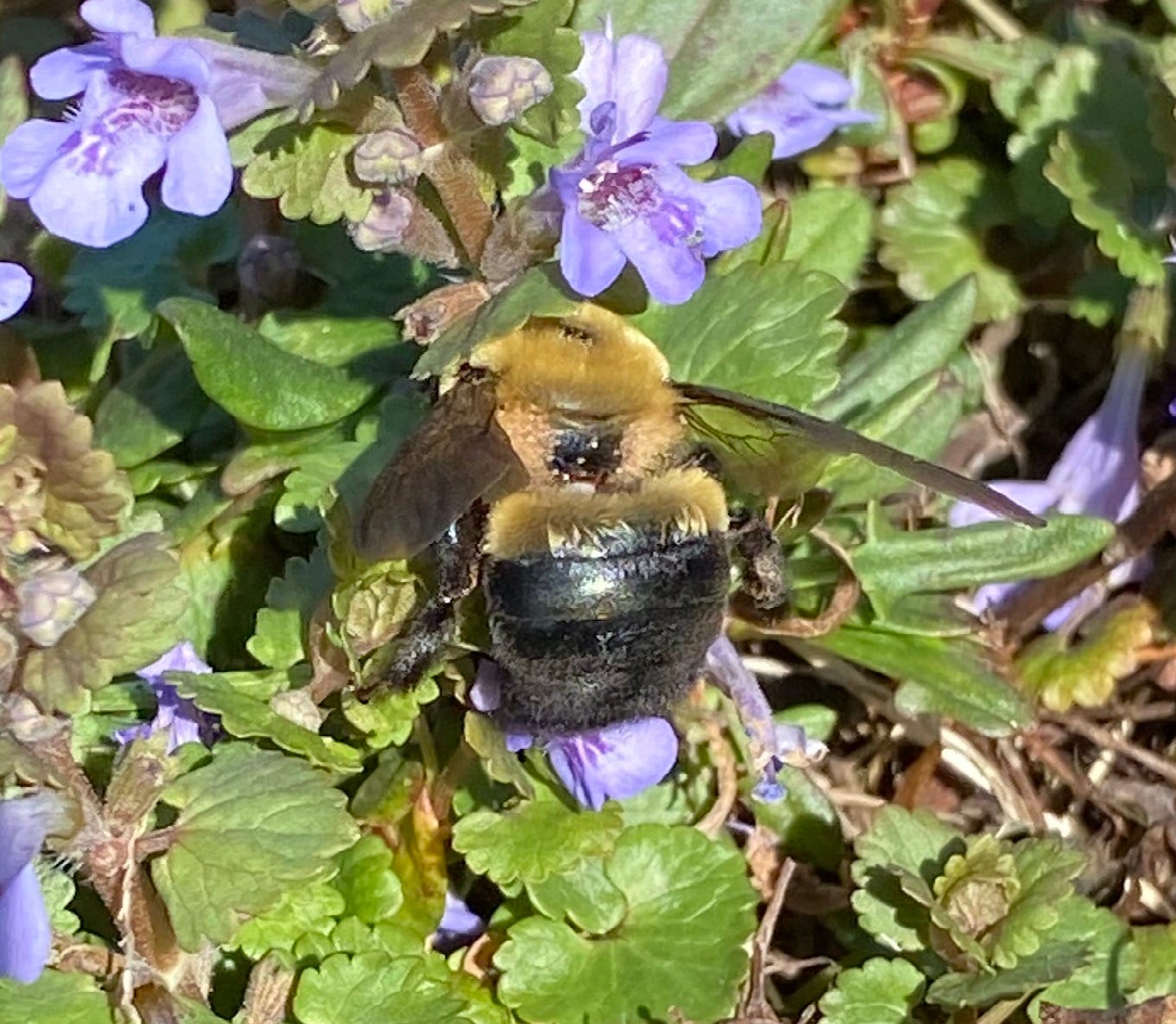The land of weedom is extremely purple now, with the Glechoma hederacea, Lamium purpureum, and Viola sororia competing for attention from the honey bees, and the hugely fat-bottomed carpenter bees.
The pull to write about the common blue violet, (Viola sororia, of the family Violaceae ) is strong, since we have used it as a soap ingredient, for years and sometimes eaten it as a spring munchie. One of our farmer’s market friends has been making jelly using these blooms, and it sells out every spring. Changing the color is a pH issue. Add a little lemon juice and the bluish tea of the blossoms turns a vivid fuschia pink.
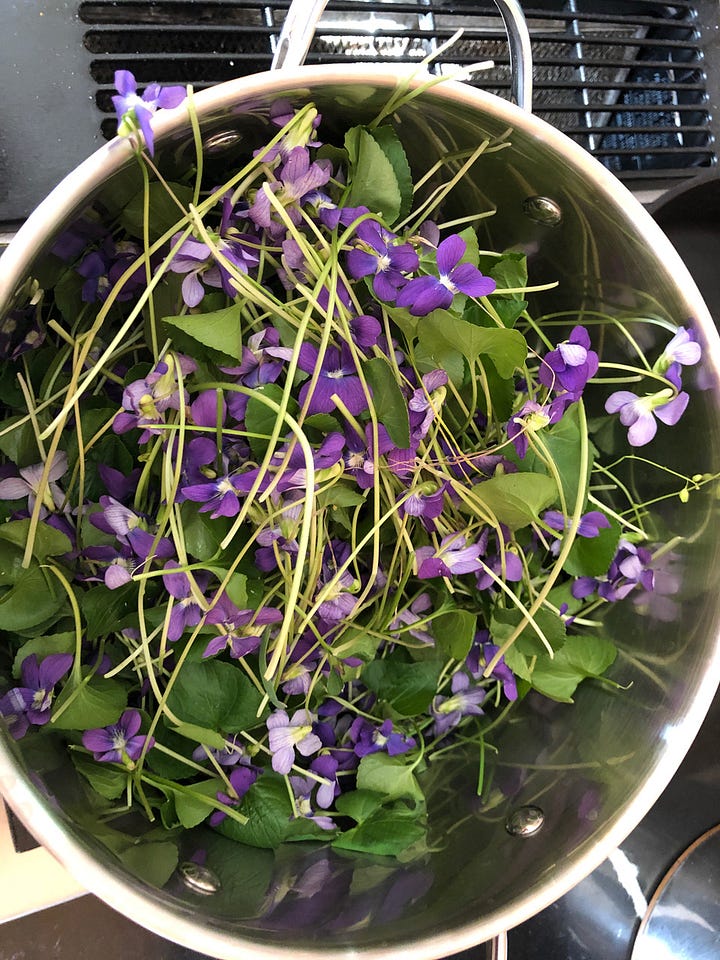
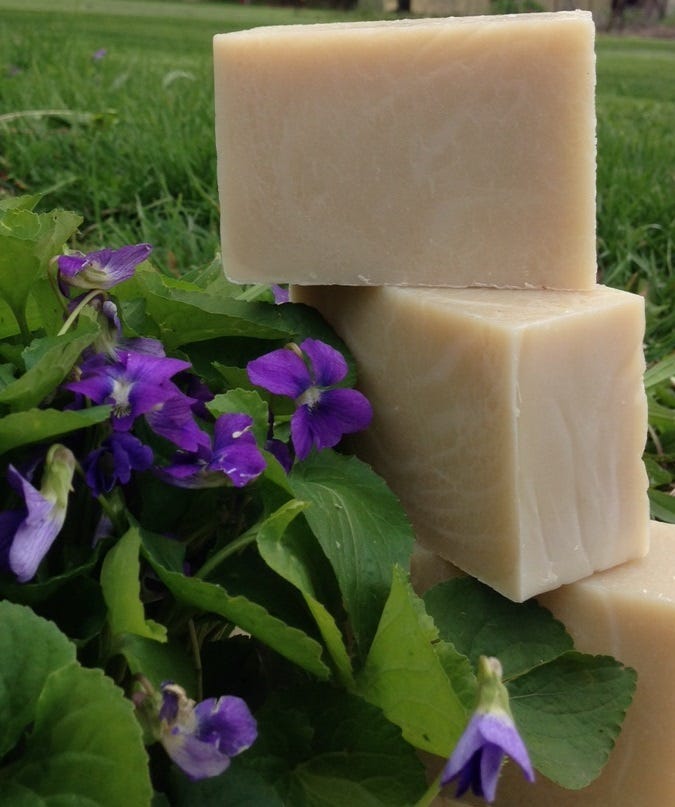
Violet leaves and flowers have been traditionally used as demulcents to sooth coughs and dry tissues, anti-inflammatory, lymphatic drainage, as diuretic, calming agitated moods, mild laxative, to address cancer, to strengthen blood vessels, to treat eczema and skin irritations, as a poultice for wounds, and to soften cysts and callused tissue. The rhizome and root is normally avoided as toxic, and it is known to cause nausea. In some countries it has purposely been used as an emetic. Violets are a major source of Vitamin A, and vitamin C, and useful as a less drying alternative to nettles as a nourishing infusion. In general, the younger leaves and the flowers are better for eating, and herbalists tend to find stronger medicinal quality in the older leaves. The most chemically studied violet is a sweet scented species, Viola odorata, however our native, and scentless, Viola sororia, has shared many of the same medicinal uses by peoples preceding the Europeans in North America. There are possibly 600 different types of violets world wide, but this is difficult to say for certain, since violets cross with each other with wild abandon, as the mints do. By the way, Viola sororia (var. sororia) and Viola papilionacea are considered to be synonyms.
Some of the prominent compounds found in Viola include volatile oils, monoterpenes, and sesquiterpenes (such as viridiflorol , linalool, cadinol and globulol) and a trace amount of melatonin, various flavonoids such as quercetin and derivatives including rutin (credited with strengthening blood vessels), salicylic acid, tannins, an alkaloid called violin, which is blamed for emetic qualities, saponins in varying quantities, and various peptides called cyclotides.
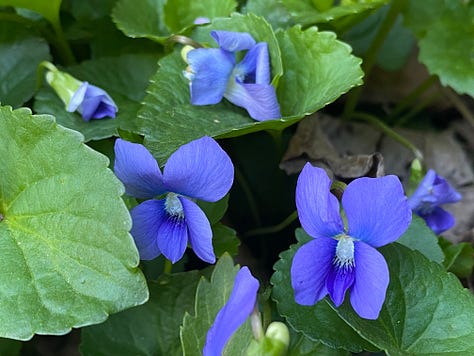
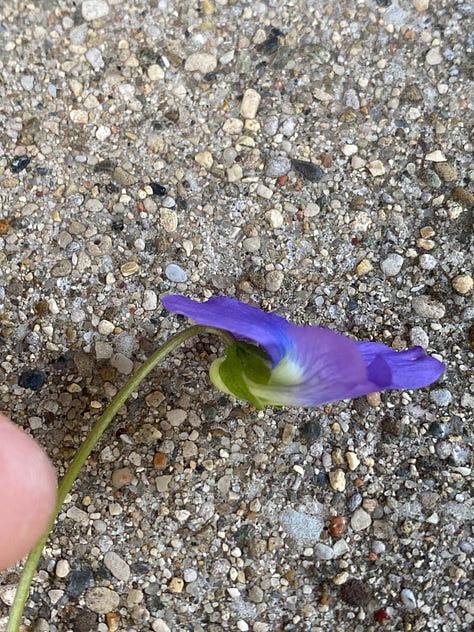
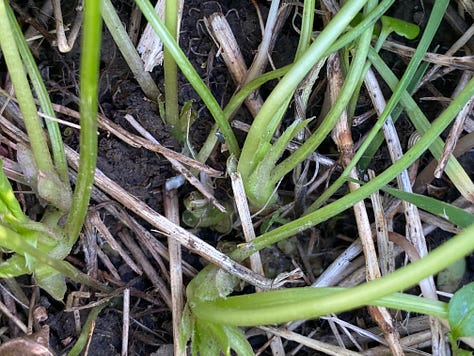
Once they have flowered, there is very little chance of mistaking common blue violets for another plant, but some might seem similar before they bloom. We are enhancing our ground ivy post with new floral pics, and you can recheck the purple dead nettle post too. One poisonous plant, which might cause confusion prior to blooming is the invasive Ficaria verna, or lesser celandine. The leaves of the young plant are fairly similar, but the bloom is a yellow ray flower. Lesser celandine later forms aerial stems, from which the leaves branch out. Common blue violet’s leaves and blooms originate directly from the rhizome. See above right. A poisonous name-alike is the African violet, a popular houseplant, which isn’t a real violet at all. It’s in the Gesneriaciae family, and has been moved from the Saintpaulia to the Streptocarpus genus, perhaps for someone else’s post graduate degree :)
Our Viola sororia is a little, perennial plant, that might get up to 8 inches high without competition. It lacks conventional stems, and the leaves and flowers spring directly up from rhizomes on or just below the ground. The rhizomes can spread into a networked mass and give rise to large patches of leaves and flowers every spring. Some species of wild violets have a pair of tiny, vestigial flap like leaves on the peduncles bearing the showy blue flowers, and we can barely see them on ours. Leaves are heart shaped with veins arranged in palmate fashion and their teeth are rounded, (crenate). The showy flowers have five petals, two above, two lateral, with some inner bristles, and one below, with track markings to form a bug landing pad. The lower petal forms a sort of spur that extends backward past the sepals surrounding the flower. These flowers can form seeds, but the violets have a backup plan. Below the leaves, close to the ground little cleistogamous (which means ‘closed marriage’) flowers form later in the growing season. These get the reproduction job done without external help. The seeds formed within these flowers have a nutritious eliosome gel that ants like, so they help to spread the seeds around. So we have a plant that can reproduce on its on via seeds, or by spreading rhizomes, or it can cross with other violets for more variety. This is why there’s no shortage of violets in our location, though in some places herbicide happy people could kill them off, and people in other parts of the world overharvest violets for medicine. To augment our pictures, check here, and here, for an assemblage of detailed views showing the cleistogamous flowers which appear later in the season, and seeds and rhizomes.
As mentioned before, the bulk of research has been done on Viola odorata. Additionally some work is being done in Eastern Europe. More information is springing up in China, where Lu, et al have been working on methods for quality control of the Violae Herba used in TCM, Traditional Chinese Medicine. Violae Herba has been listed in the Chinese Pharmacopoeia to contain Viola philippica. The genomes of the chloroplasts of various violet species were characterized in order to gain ability to screen herbal materials for the correct plant. The researchers found that the standard reference drug Violae Herba from their National Institute of Food and Drug Control contained mostly Viola prionantha, as did many commercial samples. They have suggested that the pharmacopoeia be corrected to list this different species. (At Weedom, prayers are going up for 9 researchers.)
An exciting molecular class called cyclotides has been found in plants of the Violet family, as well as the coffee or bedstraw, tomato, gourd, and legume families. This collection of some 50,000 molecules have shown antimicrobial, antiviral, immunomodulating, uterotonic, anti-inflammatory and anti-parasitic activities, and could account for numerous traditional medicinal uses of the plants. Several of these remarkably stable peptide molecules have been found within our Viola genus, e.g. Viola ignobilis, (from Russia, Eastern Europe, Iran). Esmaili, et al determined the mechanism by which one of these compounds, vigno 5 causes apoptosis , cell suicide, by HeLa cancer cells in vitro. From Viola odorata, cyclotides have been found, including cycloviolacin-O2 which showed strong activity against gram negative bacteria. This same compound showed in vitro cytotoxic activity against ovarian carcinoma cells and chronic lymphocytic leukemia cells. Viola tricolor, (heart’s ease or European wild pansy) contains a cyclotide that acts as an immune suppressant by inhibiting activated lymphocyte proliferation Unlike many other medicinal compounds that have earlier been extracted from plants, cyclotides are direct genetic products, (since genes produce mRNA, which is the template for making the peptides and proteins.) So remember that a flamin’ hot class of molecules, useful as templates for all kinds of new drug development, is in everyone’s backyard. Additional classes of these cyclic peptides exist throughout the plant and animal kingdoms. Yep, you have some too.
In research by Yousefnia et al, an ethanolic extract of Viola odorata showed activity to produce apoptosis in human breast cancer cell lines, as well as breast cancer stem cells, while showing no such activity towards an untransformed (non cancer) breast cell line. This extract also suppressed migration and colony formation of the breast cancer cell lines. This suggests a basis behind the traditional usage of violets for breast cancer, and this astonishing anecdote by herbalist Lisa Wolff, suggests that the activity extends to other violet species. Various traditional herbalists recommend the use if violet infused oil for breast massage to soothe sore nipples of breastfeeding mothers. They use violet extracts externally and internally to reduce fibrous cysts of the breasts.
Clinical research in 81 human subjects using Viola odorata showed effective use of an an ethanol extract of violet flowers dried and suspended in almond oil, (compared to placebo almond oil) in the nostrils for relief of allergy symptoms. This effect increased with continued, twice daily use up to day 14. Another study showed that administering viola infused oil used as nasal drops for a month improved sleep and insomnia scores.
A placebo controlled study of 182 chidren ages 2-12 with intermittent asthma showed that a dried Viola odorata flower 12 grams per 100 ml, (milliliters) of syrup was more effective in cough suppression compared to placebo. Children were dosed with 2.5 or 5 ml of the syrups three times daily, and all were allowed access to short acting bronchodilators, but no other meds. The violet syrup group also showed less wheezing than the control group in pulmonary examinations. Animal studies in mice showed that the Viola odorata flowers inhibited inflammatory cytokines IL-3 and IL-4 and decreased serum levels of IgE. It is possible that action on smooth muscle also mediates the positive effect of Viola on asthma, given what has been found in the use of Viola tricolor on vasculature which is also lined with smooth muscle. The water extract of that plant showed vasodilator and hypotensive effects in vitro and in animal research.
The weedom way for our Viola sororia is to take advantage of the leaves topically. This is best done by mashing up the leaves and putting them on itchy rashes, bites, eczema. Sometimes poultices are aggravating, so we make a strong infusion, put it in a spray bottle in the fridge, and spritz the itchies, irritations or rashes at frequent intervals. Spray is easier for applying herbs to animals. A strong infusion is in our Wild Violet Soap. We use the new leaves and flowers in salad. Think about extracting the flowers in water and use the color for some mixed drinks, plus or minus alcohol. Turn the color of the infusion pink using lemon juice. Put the flowers into ice cubes. You can freeze a low layer of water, then add the flower and more water and freeze again for true ice cube art. You can use a crock pot or a double boiler to infuse the flowers and/or the leaves into oil, and use it for itching or irritated skin and for breast care. (Any infused oil can be turned into an ointment by adding 1 part beeswax to 7 parts oil, melting them together and stirring. ) Consider wild violet tea with honey and marshmallow root and/or fennel seed when the respiratory bugs strike.
We suggest regular grazing among the wild edibles. So many of them exert nutritional and modulatory effects with which we have evolved. Moving away from the hyper processed food, back towards the wild or home grown food might help to relieve a lot of our inflammation and issues which have been called auto-immune. Don’t let Spring pass you by without a little weed-eating!!
Questions? Comments? We’re interested in ways to help more people get friendly with their weeds. If you like us, please share us with others. Thanks for hanging out at weedom!
Where We Dig
1. Zhang Q, Wang Q, Chen S. A comprehensive review of phytochemistry, pharmacology and quality control of plants from the genus Viola. J Pharm Pharmacol. 2023;75(1):1-32. doi:10.1093/jpp/rgac041
2. Spencer J. A Homebody’s Guide to Common Blue Violets. Dengarden. Published February 17, 2022. Accessed April 16, 2023. https://dengarden.com/gardening/Common-Blue-Violets-Viola-Sorosia
3. African Violets: How to Care for African Violets | The Old Farmer’s Almanac. Accessed April 18, 2023. https://www.almanac.com/plant/african-violets
4. Lu G, Qiao J, Wang L, et al. An integrated study of Violae Herba (Viola philippica) and five adulterants by morphology, chemical compositions and chloroplast genomes: insights into its certified plant origin. Chin Med. 2022;17(1):32. doi:10.1186/s13020-022-00585-9
5. Neverman L. Common Blue Violet - Identification, Use, Folklore. Common Sense Home. Published February 19, 2023. Accessed April 16, 2023. https://commonsensehome.com/common-blue-violet/
6. Common blue violet (Viola sororia): how to forage. Foraging for Wild Edibles. Accessed April 16, 2023. https://www.wildedible.com/common-blue-violet
7. Common Blue Violet, Viola sororia Willd. Accessed April 16, 2023. https://www.friendsofthewildflowergarden.org/pages/plants/blueviolet.html
8. Common Wild Edible Lookalikes. Mama on the Homestead. Published May 30, 2022. Accessed April 17, 2023. https://mamaonthehomestead.com/common-wild-edible-lookalikes/
9. de Veer SJ, Kan MW, Craik DJ. Cyclotides: From Structure to Function. Chem Rev. 2019;119(24):12375-12421. doi:10.1021/acs.chemrev.9b00402
10. Don’t be Deceived by This Beguiling Springtime Plant. Accessed April 17, 2023. https://extension.psu.edu/dont-be-deceived-by-this-beguiling-springtime-plant
11. ITIS - Report: Viola papilionacea. Accessed April 17, 2023. https://www.itis.gov/servlet/SingleRpt/SingleRpt?search_topic=TSN&search_value=22127#null
12. ITIS - Report: Viola sororia var. sororia. Accessed April 17, 2023. https://www.itis.gov/servlet/SingleRpt/SingleRpt?search_topic=TSN&search_value=847691#null
13. Tyler TJ, Durek T, Craik DJ. Native and Engineered Cyclic Disulfide-Rich Peptides as Drug Leads. Molecules. 2023;28(7):3189. doi:10.3390/molecules28073189
14. Chandra D, Kohli G, Prasad K, et al. Phytochemical and Ethnomedicinal Uses of Family Violaceae. Current Research in Chemistry. 2015;7(2):44-52. doi:10.3923/crc.2015.44.52
15. Science Supports Viola’s Traditional Medicinal Value | American College of Healthcare Sciences. Published July 8, 2022. Accessed April 18, 2023. https://achs.edu/blog/2022/07/08/science-supports-violas-traditional-medicinal-value/
16. Yousefnia S, Naseri D, Seyed Forootan F, et al. Suppressive role of Viola odorata extract on malignant characters of mammosphere-derived breast cancer stem cells. Clin Transl Oncol. 2020;22(9):1619-1634. doi:10.1007/s12094-020-02307-9
17. Academy H. The Virtues of Violets - Health Benefits of Violets. Herbal Academy. Published April 29, 2014. Accessed April 16, 2023. https://theherbalacademy.com/health-benefits-of-violets/
18. Viola papilionacea page. Accessed April 16, 2023. http://www.missouriplants.com/Viola_papilionacea_page.html
19. Esmaeili MA, Abagheri-Mahabadi N, Hashempour H, Farhadpour M, Gruber CW, Ghassempour A. Viola plant cyclotide vigno 5 induces mitochondria-mediated apoptosis via cytochrome C release and caspases activation in cervical cancer cells. Fitoterapia. 2016;109:162-168. doi:10.1016/j.fitote.2015.12.021
20. Viola sororia (Common Blue Violet, Confederate Violet, Dooryard Violet, Florida Violet, Hooded Blue Violet, Hooded Violet, Meadow Violet, Missouri Violet, Purple Violet, Sister Violet, Violets, Wild Violet, Wood Violet, Woolly Blue Violet) | North Carolina Extension Gardener Plant Toolbox. Accessed April 16, 2023. https://plants.ces.ncsu.edu/plants/viola-sororia/
21. Viola sororia (woolly blue violet): Go Botany. Accessed April 16, 2023. https://gobotany.nativeplanttrust.org/species/viola/sororia/
22. Mcdonald, Jim. Violet Herb. HerbalRemediesAdvice.org. Accessed April 17, 2023. https://www.herbalremediesadvice.org/violet-herb.html
23. Blankespoor J. Violet’s Edible and Medicinal Uses. Chestnut School of Herbal Medicine. Published April 13, 2016. Accessed April 18, 2023. https://chestnutherbs.com/violets-edible-and-medicinal-uses/
24. Viva Violets! by Lise Wolff. Accessed April 17, 2023. http://www.herbalistlisewolff.com/violets.html
25. Wild Violets. Turfgrass Science at Purdue University. Published June 12, 2013. Accessed April 16, 2023. https://turf.purdue.edu/wild-violets/






